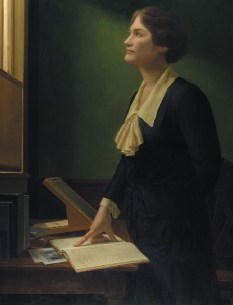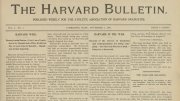On February 11, a portrait of astronomer Cecilia Payne-Gaposchkin was scheduled to be unveiled on the wall of the Faculty Room in University Hall, where males greatly predominate. There is one other woman in oil on canvas with her on the walls--the historian Helen Maud Cam--and considerably more in flesh and blood on the chairs at faculty meetings.
 |
| The Faculty Room's newcomer, Cecilia Payne-Gaposchkin |
| Portrait courtesy of the Harvard University Portrait Collection, © President and Fellows of Harvard College, gift of Professor Dudley R. Herschbach and Georgene B. Herschbach. Photograph by Katya Kallsen |
Cecilia Helena Payne was born in Wendover, England, in 1900. She received the B.A. degree from Newnham College, Cambridge, in 1923 and, believing that opportunity would be greater for a female astronomer in the New World, began work that year as the first graduate student in astronomy at the Harvard Observatory. She earned the Ph.D. in 1925. Her doctoral thesis was judged by a senior astronomer of her time to be the most brilliant ever written in astronomy. "It established definitively that the stars are all essentially of the same composition, despite their differing appearances," says Owen Gingerich, research professor of astronomy and of the history of science. "Moreover, it pointed the way to a conclusion she was reluctant to accept, but that would in later years be seen to be accurate, that the elements hydrogen and helium are fantastically abundant in the stars."
In 1934 she married fellow Harvard astronomer Sergei I. Gaposchkin, with whom she made several million observations of thousands of variable stars. She wrote more than 150 papers and nine books. At her death in 1979, Charles Whitney, now professor of astronomy emeritus, praised her particularly as a teacher. She was a superb lecturer, he said, "because she was able to convey the same sense of wonder that she felt to her audience. They were simply swept along by her enthusiasm...." Payne-Gaposchkin, Whitney declared, was "one of the greatest astronomers in history, and the greatest woman astronomer in history."
She was first in other ways as well. In 1938 she was appointed Phillips astronomer in the Harvard College Observatory without limit of time and lecturer on astronomy, becoming the first woman to receive tenure in the Faculty of Arts and Sciences (FAS). Eighteen years later she was made professor of astronomy and chair of the department, the first woman to chair a department in FAS. Payne-Gaposchkin was also the first woman to be appointed professor from within the Faculty of Arts and Sciences. (Cam was the first woman to be appointed professor in FAS, in 1948, but she came from outside, from the University of Cambridge, to be the inaugural incumbent of the Zemurray Stone-Radcliffe professorship, which is reserved for women.) In 1958 Payne-Gaposchkin was named the Phillips professor of astronomy.
Her portrait is by Patricia Watwood of New York City, who worked from about 25 photographs of her subject at different ages, there being no single photograph of Payne-Gaposchkin that seemed just right, says Sandra Grindlay, curator of the Harvard University Portrait Collection. Its composition derives from Vermeer's The Astronomer at the Louvre.
The painting was commissioned and given by Baird professor of science Dudley R. Herschbach and his wife, Georgene Botyas Herschbach, associate dean of Harvard College, through a gift trust established with funds from his 1986 Nobel Prize in chemistry. For more than 30 years, Dudley Herschbach has argued that there should be more women on the faculty (see "Women in Science Redux," May-June 2001, page 63), and he has agitated for "affirmative action for portraits," as he puts it. When Georgene Herschbach, of like mind, saw in 1997 that not one of the portraits in the new Barker Center for the Humanities was of a woman, she offered the portrait of Helen Keller that hung on her office wall, and the offer was accepted.
The number of portraits of faculty members in the Faculty Room is greater by one. All paintings and busts were removed for the renovation of the 1813 building that was completed last year, and when they came back, a Gilbert Stuart portrait of Harvard benefactor Benjamin Bussey was added to the crowded walls as a placeholder for the portrait of Payne-Gaposchkin, then in the making. Bussey has now departed.





